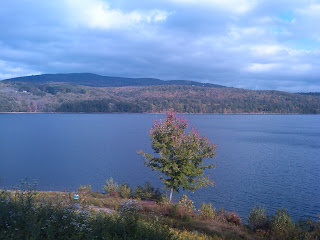― Richard Carlson, Don't Sweat the Small Stuff ... and it's all small stuff: Simple Ways to Keep the Little Things from Taking Over Your Life
My friends know I have a Type A personality. They may not know it was created from a household where my mother couldn't keep house, my father couldn't screw in a light bulb and my sister tried to make herself disappear whenever she could. So, I felt, I had to keep things running. I still do.
 |
| Pods on the grass, the type of "small stuff" that keeps me going. (Margo D. Beller) |
The line that really gets my blood boiling is when she says how glad she is she no longer has to "sweat the small stuff."
What would that be, ma'am?
Would that be cleaning up your little room? Would that be cooking a meal for yourself? Would that be walking the dog, raking the leaves, working in the garden, running to the library?
No, of course not. You have everything you need right there and if you do want to go somewhere, the complex will put you in a van and take you there.
For those older, more infirm folks, I can see the appeal of this. My in-laws are in their 80s and very glad to sell their suburban home for a NH condo closer to their grandchildren, where there are lots of activities, a hospital is down the road and they don't have to shovel the snow or work on the greenery outside. I bless my father-in-law every time I use the tools he left behind.
But this morning, as I raked yet more pods to the curb ahead of my town's leaf vac coming by, I wondered what I would do if I no longer had to "sweat the small stuff."
 |
| My way of not sweating the small stuff. (RE Berg-Andersson) |
I have the type of personality that has to work against something. For many years it was a job away from home, where if I wanted to do anything I wanted to do, I had to either do it before my two-hour commute or once I got home from work 12 hours or so later or wait for the weekend. Even after I started working from home I'd have to work around my various shifts.
At the moment it's getting those damned pods off my lawn.
One of my friends envies me my now semi-retired status, semi-retired because I still do some freelance work, I just don't get as much of it or get paid as well as I was before my biggest client decided to go without my editing services. I have a lot of time to fill. Sure, I can read all day but how will that pay the bills? I tell her that every day seems the same to me now, weekends and holidays are just another day. Most days I wake up and have to remind myself what day it is.
But at least I still wake up. I still put out the bird feeders in the cold dawn, refill the water dish, watch the Canada geese fly overhead (even if these are local geese flying north instead of south for the winter). I still make supper for MH and myself, and when I don't feel like it we go out. I even clean my own house every so often. I don't feel compelled to mingle with people if I don't feel like it, and I can still afford to pay the taxes on this property. The idea of an "active adult community" fills me with horror, mainly because I know I'd have to be in really bad condition physically, financially or both, to force me from my home.
As a couple without children, whose friends live some distance away and who are aging every day, the small stuff of what happens in future is a problem for another day.















